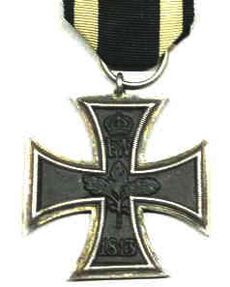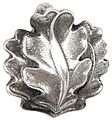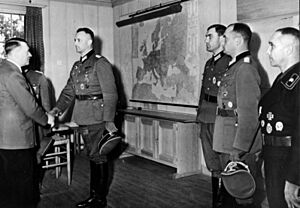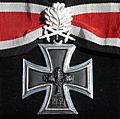Knight's Cross of the Iron Cross facts for kids
Quick facts for kids Knight's Cross of the Iron CrossRitterkreuz des Eisernen Kreuzes |
|
|---|---|
 |
|
| Awarded for | The Knights Cross of the Iron Cross is presented as a large iron cross supported by a band that is in the tricolor of the German Empire (Red, White and black). The cross itself has a large swastika in the middle of it with the year 1939 on the bottom arm, while the backside is vacant of any markings. Depending on the version, the award can have a specific clasp supporting the cross on the ribbon, these include:
Oak leaves Oak leaves and swords Oak leaves, swords and diamonds Golden Oak leaves with swords and diamonds |
| Presented by | the Führer and Reich president |
| Country | |
The Knight's Cross of the Iron Cross was a very important military award in Nazi Germany during World War II. It was the highest award given for bravery or great leadership. It was given to soldiers, sailors, and airmen. It was also given to members of other groups that helped in the war.
This award was created on September 1, 1939, when Germany invaded Poland. It replaced older awards for bravery. Over time, different levels of the Knight's Cross were added. More than 7,000 of these awards were given out during the war.
What is the Knight's Cross?
The Knight's Cross was based on an older award called the Iron Cross. The Iron Cross was first created in 1813 by the Prussian king Friedrich Wilhelm III. It was made of cast iron with a silver frame. Iron was chosen to show strength and determination.
The Iron Cross was brought back for wars in 1870 and 1914. When World War II began in 1939, Adolf Hitler decided to bring back the Iron Cross again. He also created the new Knight's Cross of the Iron Cross. This new award was given to both officers and regular soldiers.
Records show that 7,161 people officially received the Knight's Cross. Higher levels of the award were given to fewer people. For example, the highest level, the Knight's Cross with Golden Oak Leaves, Swords, and Diamonds, was only given once.
Different Levels of the Award
As the war continued, leaders needed a way to recognize soldiers who kept showing great bravery. So, the Knight's Cross was eventually given in five different levels:
- Knight's Cross of the Iron Cross
- Knight's Cross of the Iron Cross with Oak Leaves
- Knight's Cross of the Iron Cross with Oak Leaves and Swords
- Knight's Cross of the Iron Cross with Oak Leaves, Swords, and Diamonds
- Knight's Cross of the Iron Cross with Golden Oak Leaves, Swords, and Diamonds
The Basic Knight's Cross
The first Knight's Cross was created on September 1, 1939. It looked a lot like the original Iron Cross. It had a special shape, wider at the ends than in the middle. Many of these crosses were made by a company called Steinhauer & Lück.
Knight's Cross with Oak Leaves
The Knight's Cross with Oak Leaves was added on June 3, 1940. This was for soldiers who had already received the basic Knight's Cross but continued to show great bravery or leadership. The Oak Leaves design was not new. It had been used with other German awards before.
Knight's Cross with Oak Leaves and Swords
This level was created on July 15, 1941. It looked like the Oak Leaves award, but it also had two crossed swords added to the design. This showed even greater achievement.
Knight's Cross with Oak Leaves, Swords, and Diamonds
Also created on July 15, 1941, this was a very high level of the award. It included diamonds on the design. Only 27 people received this award during World War II. Some recipients, like Hans-Joachim Marseille, died before they could officially receive their diamonds.
-
Helmut Lent's Diamonds, Bundeswehr Military History Museum.
Knight's Cross with Golden Oak Leaves, Swords, and Diamonds
This was the highest level of the award, created on December 29, 1944. It was meant for the most outstanding servicemen. Only one person, Hans-Ulrich Rudel, received this award. It was made of 18-carat gold with real diamonds.
How Were Awards Approved?
| Award |
|
Nomination |
||||||||||||||||||||||||||||||||||||||||||||||||||||||||||||||||||||||||||||||||||||||||||||||||||||||||||||||||||||||||||||||||||||||||||||||||||||||||||||||||||||||||||||||||||||||||||||||||||||||||||||||||||||||||||||||||||||||||
To get the Knight's Cross, a soldier usually needed to have already received the Iron Cross First Class. Sometimes, both awards were given at the same time. Commanders could also receive the medal if their unit performed very well.
For example, U-boat commanders could qualify for sinking 100,000 tons of enemy ships. Air force pilots could earn points for shooting down enemy planes. The requirements became stricter as the war went on.
Nominations for the Knight's Cross started at the company level or higher. A soldier could not nominate themselves. The nomination had to be written down and sent up the chain of command. Each commander in the chain had to approve it.
After approval, the recipient would get a telegram saying they had won the award. They also received a temporary certificate. The award was noted in their military records.
From 1939 until Adolf Hitler's death in 1945, Hitler had to approve all Knight's Cross awards. After his death, it became unclear who had the power to approve them.
Who Received the Award?
Official records show that 7,161 people received the Knight's Cross. This includes 863 who received the Oak Leaves, 147 who received the Swords, and 27 who received the Diamonds.
Hitler often presented the Oak Leaves and higher levels of the award himself. These ceremonies took place in places like Berlin or his mountain home, the Berghof. Later in the war, presentations were also made at his military headquarters. After a failed attempt on his life in 1944, Hitler presented fewer awards in person. Other senior commanders began to present them instead.
Post-War Rules
After World War II, Germany made new laws about wearing military awards. German law does not allow wearing a swastika. So, in 1957, the West German government allowed new versions of the Knight's Cross to be worn. These new versions had an Oak Leaf Cluster instead of the swastika. This allowed World War II veterans to wear their awards legally.
See also
 In Spanish: Cruz de Caballero de la Cruz de Hierro para niños
In Spanish: Cruz de Caballero de la Cruz de Hierro para niños









